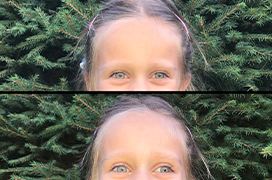Aim: This retrospective clinical study evaluates the results of surgical treatment of patients diagnosed with intermittent exotropia of the divergence excess type. The study compares the results of surgery delayed due to the Covid-19 pandemic (patients underwent the surgery after the age of eight), versus a group of younger children.
Materials and methods: The objective angle of deviation and quality of binocular functions were examined. The follow-up period was six months after surgery. The patients were divided into two groups according to age: 4–7 years and 8–13 years.
Each group included 20 patients. The second group comprised patients whose surgery was postponed due to restrictions on elective surgery during the ongoing pandemic. The surgery took place at the University Hospital in Pilsen. Angle of deviation and binocular functions were examined before surgery, postoperatively, and three and six months after surgery. Data were collected retrospectively and statistically processed. The main values were plotted in charts.
Results: Accordance between the angle of deviation before surgery in both groups was statistically demonstrated. During the six-month follow-up period, the median angle of deviation was statistically without proof of disparity between the groups. Six months after surgery, an objective angle of deviation within the limit ±5 degrees was achieved in 65% of patients from the first group and in 75% from the second group.
Binocular vision before surgery was statistically without proof of difference between both groups. However the statistical processing demonstrated a difference between the two groups six months after the surgery. Better binocular functions were achieved by the younger children in the first group.
Conclusion: The objective deviation angle was comparable in both study groups prior to surgery as well as six months after the surgery. The first group of younger patients attained a higher quality of binocular functions within the six-month follow-up period compared to children operated on after the age of eight. This claim was statistically verified.

